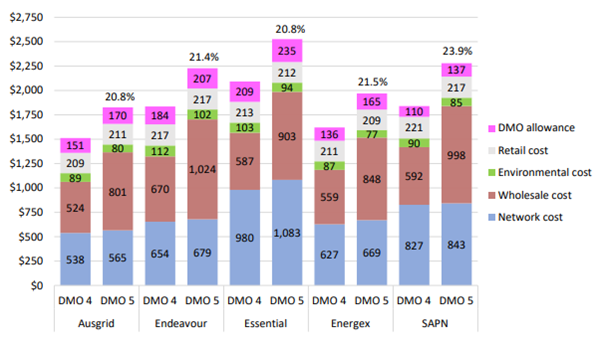Australian energy price increases over August and September were amongst the highest in the world and a lot higher than our trading partners and other major energy producers.
I questioned why this was happening. As the Economic Director for Compare The Market, I challenged the energy team to find the answer. It turns out the reason we’re paying higher energy prices is because, after years of neglect, we have to rebuild our energy infrastructure.
Compare the Market is warning Australians that electricity prices could remain high for the next decade, with consumers bearing the brunt of network transformations.
Latest figures show wholesale electricity prices in the National Electricity Market were down around 50 per cent on the previous year in many states… so why are household energy prices remaining high?
The answer is there is more to pricing than just wholesale costs, with a mix of environmental and business costs weighing heavily on bills.
Outdated electricity grids and networks have been expensive to maintain and will cost even more to transform over the next 10 years. None of these changes will happen overnight, so we could face a long, protracted period of price pressure.
Wholesale prices only account for a third of what makes up your energy bill. A range of other factors will continue to influence energy prices in 2024.


Source: AER’s Default market offer prices 2023–24
Just as you’ve noticed prices increasing across the board in your daily life, network costs are going up for our energy distributors and retailers. Due to inflation, the cost of materials to maintain the network has increased, rising fuel costs mean it’s costing more for distributors to read meters, update wires and transform the grid.
On top of that, Australia has renewable energy commitments to meet. While federal and state governments, retailers and distributors are working to make that happen, it costs a lot of money. Unfortunately, consumers foot part of that bill.
The fact of the matter is that there wasn’t previously a lot of investment or forward-thinking into the renewables transition.
But some discounts are available for people willing to take the time to sniff them out. At the time of writing, there were energy plans with up to 18 per cent off the reference price on Compare the Market’s energy panel.
So don’t switch off, but switch over, to save money.
Hundreds of thousands of households are on so-called ‘standing offers’ which means they’re paying more than they need to. Energy retailers are legally obligated to display the percentage difference between their market electricity plan on offer and the default offer – which makes it easy to compare.
What else is in your energy bill?
Distributor costs
In addition to the price retailers pay for wholesale electricity, they also need to factor in costs to transport and distribute electricity to households – which have gone up due to inflation.
Distributors are the energy companies that maintain the gas pipes, electrical poles and wires and read electricity and gas meters.
So as the cost of materials and transport has gone up, it’s been passed on to consumers through their energy bills.
Environmental costs
Renewable energy is really ramping up in Australia and while we should eventually see prices fall, it does come with an upfront investment and transitional period.
What many people don’t realise is that while national and state-based schemes require retailers to produce a set amount of renewable energy, retailers incur a cost to implement these strategies.
Bulk buying
Retailers purchase electricity ahead of time at a fixed price to help mitigate risks in a volatile market.
This can mean that if prices drop, it can take time for customers to see the benefits.
Retail costs
Regulators also factor in costs that retailers incur to sell electricity.
It’s best to think of these retailers as businesses. Like any business, there are day-to-day costs to operate and service customers, market to customers, install and maintain meters.
They also need to put funds aside for customers who don’t pay their bills, are in debt or need to be on hardship programs.
Retail allowance
Energy regulators want customers to have access to fair and affordable electricity plans. To do this, there’s a retail allowance factored into the DMO and VDO, which encourages retailers to invest, innovate and compete in the market.
But remember, retailers are free to set prices above the DMO or VDO, so the idea of the retail allowance is to encourage them to offer deals lower than the standing offer.
Metering costs
As Australia’s electricity grid continues to evolve, so do the types of meters that help determine how much electricity we’re using.
Advanced metering infrastructure is being rolled out to more homes across Australia, allowing electricity to be read remotely, data to be tracked regularly, and more.
But these new technologies cost money to roll out. It’s a balancing act between getting the most effective new devices into homes, while managing costs faced by consumers.
Get Kochie’s weekly newsletter delivered straight to your inbox! Follow Your Money & Your Life on Facebook, Twitter and Instagram.
Read this next:
Energy prices are set for a massive increase again… but why?




























Trending
Sorry. No data so far.